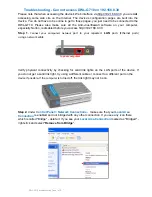
MERCURY ELITE PRO Qx2
DEVICE SETUP
7
RAID 10 “Drive Mirroring with Striping” Mode (Four Drives Installed)
Dial position: 1
The drives show up as one volume with a size equal to the combined capacities of
half of the drives used in the array. RAID 10 creates an exact copy (or “mirror”) of a
set of data but also uses a RAID 0 “stripe” for speed. When one drive fails, it can be
replaced and the data will be rebuilt automatically.
RAID 5 “Drive Striping with Parity” Mode (Three or Four Drives Installed)
Dial position: 3
The drives show up as one volume with a size equal to the combined capacities of
all the drives in the array, minus one drive. RAID 5 uses block-level striping with parity
data distributed across all disks and therefore provides the perfect balance between
high performance and data integrity. When one drive fails, it can be replaced and the
data will be rebuilt automatically.
2.4 CHANGING DRIVES
2.4.1 Adding and Removing Drives in Independent Mode
When the Mercury Elite Pro Qx2 is set to independent mode, you can add or remove any
drive without needing to create a new RAID set.
IMPORTANT NOTE:
To avoid data corruption it is essential to unmount all drives and
turn off the Qx2 before removing or adding a new drive. If you physically remove a drive
from the Qx2 without powering it off first, any mounted drives will improperly unmount
from the computer.
2.4.2 Adding Drives to an Existing RAID Set
It is not possible to add more drives to an existing RAID set. In order to add drives, a new
RAID set must be created, which will destroy the data on the existing RAID set. If you wish
to add more drives, shut off the Qx2, then add the drives. Once all of the drives that you
wish to use are installed, go through the steps in section 2.3.1 to create the new RAID set.
2.4.3 Replacing Drives
When one of the drives fails, the corresponding LED will turn off. If only one drive has
failed and the RAID mode is set to RAID 1, RAID 10, or RAID 5, the data on the RAID
set will still be accessible, but it is strongly suggested that you replace the failed drive
immediately with another drive of identical model and capacity to ensure the continued
safety of your data.






























